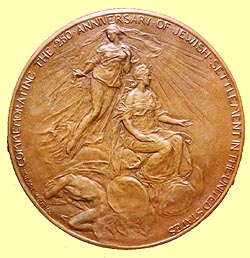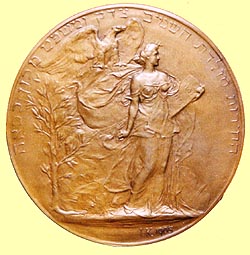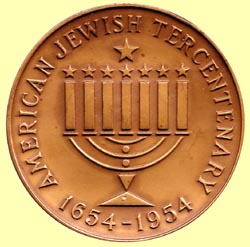|
|
 |
|
May
1, 2003
350th Anniversary of Jewish Life in America Medal
A committee has been established to choose the design of the official
medal celebrating the 350th Anniversary of Jewish Life in America,
which will be celebrated nationally from September 2004 through
September 2005.
The Chairman
of the 350th Anniversary Medal Committee is Mel Wacks, Founding
Director of the Jewish-American Hall of Fame, President of the
American Israel Numismatic Association, and a judge for Krause
Publications’ COTY (Coin of the Year) Award. The other members
of the Medal Committee are Dr. Ira Rezak, a major collector of
Judaic medals and a member of the Medals and Decorations Committee
of the American Numismatic Society; and Daniel Friedenberg, the
Dean of Judaic Numismatics, former Curator of Coins and Medals
for The Jewish Museum, author of Jewish Medals from the Renaissance
to the Fall of Napoleon, Jewish Minters & Medalists, Great
Jewish Portraits in Metal, etc.
The Medal
Committee will invite a small group of American Jewish medalists
to submit designs, and will choose the most appropriate to be
sculpted for the medal. The medal will be 3” diameter, the
same as the official 250th and 300th Anniversary medals. They
will be made in limited editions of bronze, silver and gold to
be presented to public officials, participants in the celebration,
and contributors.
In the tradition
of financier Jacob Schiff defraying the cost of the 250th Anniversary
of the Settlement of the Jews in the United States medals 100
years ago, David Berley, President of Walter & Samuels, has
generously underwritten the 350th anniversary medals.
The Jewish-American
Hall of Fame Division of the American Jewish Historical Society
will coordinate the production and distribution of the official
medals celebrating the 350th Anniversary of Jewish Life in America.
To receive further information e-mail info@amuseum.org or write
to Jewish-American Hall of Fame, 5189 Jeffdale Ave., Woodland
Hills, CA 91364.
 |
 |
Official
medal commemorating the 250th Anniversary of the Settlement
of the Jews in the United States, designed by Isidore
Konti, issued in 1905.(Photo courtesy of Dr. Ira Rezak.) |
 |
 |
Official medal commemorating the American Jewish Tercentenary, issued in 1955, obverse designed by William Metzig (1893-1989) and reverse designed
by Nancy Dryfoos (1918-1991). |
Dr. Michael
Feldberg, Director of the American Jewish Historical Society,
describes the tortuous journey of those first settlers in “Blessings
of Freedom” (KTAV Publishing House, 2002):
The Dutch
had captured Brazil from the Portuguese in 1630, and Jews from
Amsterdam had settled in the new colony (of Recife), where they
openly practiced their religion. When Portugal recaptured Brazil
in 1654, it expelled the Jews. The twenty-three who landed in
New Amsterdam had set out for Amsterdam on a vessel called the
Ste. Catherine. En route, after stops in Jamaica and Cuba, the
Ste. Catherine was captured by a Spanish privateer and the passengers
were stripped of their valuables.
A return
to Europe was now out of the question. The refugees struck a deal
with the ship’s captain, Jacques de la Mothe, to take them
to New Amsterdam, which they thought would be a hospitable destination.
De la Mothe agreed to divert his ship for a fee of 2,500 guilders.
When the
Ste. Catherine landed in New Amsterdam (in the first week of September
1654), Captain de la Mothe sued his propertyless passengers for
failure to pay the balance of their passage. Peter Stuyvesant
(1592-1672), the Dutch colonial governor, seized the Jews’
meager remaining possessions and ordered them sold at auction
to meet their debts. When the auction failed to raise sufficient
funds to pay Captain de la Mothe, Stuyvesant jailed two of the
refugees and wrote to the Dutch West India Company in Amsterdam
asking permission to expel the entire group. Noting that the Jews’
indigence might make them a burden to the community, Stuyvesant
“deemed it useful to require them in a friendly way to depart.”
The Jewish
community in Amsterdam petitioned the company on behalf of their
fellow Jews in New Amsterdam, noting that Jews were allowed to
reside in Holland, even to invest in the company, and thus should
be allowed to reside in New Amsterdam. In April 1665, the company
granted Jews permission to live in New Amsterdam (New York) “so
long as they do not become a burden to the Company or the community.”
Click
here for information about the Jewish-American Hall of Fame’s
tribute to the First Jewish Settlers. |